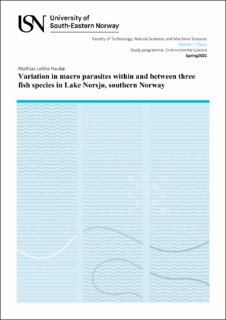| dc.contributor.advisor | Lydersen, Espen | |
| dc.contributor.author | Haukø, Mathias Leithe | |
| dc.date.accessioned | 2021-08-27T16:12:33Z | |
| dc.date.available | 2021-08-27T16:12:33Z | |
| dc.date.issued | 2021 | |
| dc.identifier | no.usn:wiseflow:2577805:42441526 | |
| dc.identifier.uri | https://hdl.handle.net/11250/2771616 | |
| dc.description.abstract | I innsjøer som huser flere fiskearter er interspesifikk konkurranse blant fisk en kjent driver for bruk av habitat og fødevalg blant de ulike fiskeartene. Fødevalg og habitatbruk kan også se ut til å påvirke variasjon i abundants, prevalens og diversitet av parasitter innen og mellom fiskearter. Videre fører bioakkumulering av trofisk overførte parasitter til høyere abundants i større og eldre fisk. I denne studien ble variasjon i parasittabundants innad i, og mellom fiskeartene røye Salvelinus alpinus, sik Coregonus lavaretus og abbor Perca fluviatilis i relasjon til habitatbruk og trofisk posisjon undersøkt.
I 2018 ble 75 røye, 50 sik og 75 abbor fisket med garn i tre lokasjoner over tre sesonger (vår, sommer, høst) i Norsjø som er en stor, dyp og oligatrofisk lavlands-sjø i Sørøst-Norge. Makro endo- og ektoparasitter ble innsamlet fra fiskene og artsbestemt. Fiskelengde- og vekt ble målt, kjønn og alder bestemt, og d13C og d15N signaturer ble analysert for å spore kilde til organisk karbon og bestemme trofisk nivå, respektivt. Generaliserte lineære mikset effekt modeller (GLMM) ble brukt til å analysere effekt på total parasittabundants, og generaliserte minste kvadrater (GLS) til å analysere effekt på stabile isotoper innad og mellom fiskeartene.
Signifikant forskjell i parasittabundants, trofisk posisjon og habitatbruk ble funnet mellom de tre undersøkte fiskeartene. Røye hadde en profundal habitatbruk, høyeste trofisk posisjon og høyeste parasittabundants samt størst variasjon i parasittfauna. Sik utviste en pelagisk til litoral habitatbruk, laves trofisk nivå, men høyeste individuelle variasjon i trofisk nivå, i tillegg til nest høyest abundants og diversitet i parasitter. Abbor hadde lavest variasjon i trofisk posisjon og den høyeste variasjonen i habitatbruk. Abbor hadde også lavest abundants og diversitet av parasitter. Fiskelengde var den mest signifikante effekten for parasittabundants for både røye og sik, og nest viktigst for abbor. Variasjon i føde, trofisk posisjon og fiskestørrelse var de viktigste faktorene for parasittabundants og diversitet av parasitter blant sik, abbor og røye. I tillegg ble det funnet at habitatbruken og føde ser ut til å være avgjørende for hvilke parasitter fisken får. | |
| dc.description.abstract | Interspecific competition among fish in multispecies lakes is known as an important factor for choice of habitat and feeding by the different species. Feeding and habitat use also seem to affect abundance, prevalence, and diversity of parasites within and between fish species. In addition, bioaccumulation of trophic transmitted parasites are increasing the parasite abundance in larger and older fish. In this study, variation in parasite abundance between and within Arctic charr Salvelinus alpinus, whitefish Coregonus lavaretus and perch Perca fluviatilis in relation to habitat use and trophic position were investigated.
In 2018, 75 Arctic charr, 50 whitefish and 75 perch were caught by using gill nets in three locations over three seasons (spring, summer, fall) in Lake Norsjø, a large and deep oligotrophic lowland lake in southern-eastern Norway. Macro endo and ecto parasites were sampled and determined. In fish, length and weight measured, sex and age determinate, and d13C and d15N signatures were analysed to reveal organic carbon source (habitat use) and trophic position. Generalized linear mixed effect models were used to investigate effects on total parasite abundance and generalized least squares were used to analyse effects on trophic position and habitat use within and between the three fish species.
Significant difference in parasite abundance, trophic position and habitat use were revealed between the three investigated fish species. Arctic charr exhibited profundal habitat use and highest average trophic position, highest parasite abundance and highest parasite diversity. Whitefish were revealed to have a pelagic-littoral habitat use, the lowest average trophic position, and the largest range in trophic position in addition to the second highest parasite diversity and abundance. Perch had the lowest range in trophic positions and the highest diversity in habitat use. In addition, perch had the lowest abundance and diversity of parasites. Fish length was the most important factor for parasite abundance in Arctic charr and whitefish and the second most important perch after season. Dietary breadth, trophic position and fish size were most important for the total parasite abundance and diversity of parasites in the three investigated fish species. In addition a segregation in parasite fauna were related to habitat use. | |
| dc.language | eng | |
| dc.publisher | University of South-Eastern Norway | |
| dc.title | Variation in macro parasites within and between three fish species in Lake Norsjø, southern Norway | |
| dc.type | Master thesis | |
